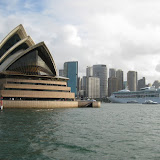 When I landed in Cape Town on a Friday, I had this idea that I’d have an apartment by the following Monday. That was a silly idea.
When I landed in Cape Town on a Friday, I had this idea that I’d have an apartment by the following Monday. That was a silly idea.I started by asking other interns about where they thought I should look.The top three areas I heard from anyone were Observatory, Sea Point, and Gardens. I’d started out in a hostel in Observatory. It was close to our office, and it was a student neighborhood with a history of cafes and performing arts patronized by people of all races even during apartheid. That sounded like just the neighborhood for me.
So my second night there, I asked the hostel staff where I should go for the popular bars, restaurants, etc. They told me to go to Lower Main St.
I followed the directions they’d given me and found the street they were talking about. It was cordoned off with police tape. Someone had just been robbed and shot by a stranger who got away in a car.
I went back the next day during daylight hours at the Obz Cafe, across the street from the crime scene, and sat at the bar for lunch. I chatted up the bartender and asked him what had happened. After telling me, he also told me that a week previously, one of his friends had been shot and killed by complete strangers who wanted to rob him. He'd had a wife and three young children. When I left after paying the bill, I said again I was sorry for the loss of his friend. He shrugged and said, “that’s life.” I think that attitude got my attention more than the actual shooting did.
I decided to look at a safer neighborhood, one where I didn’t get ominous looks from hostel staff when I went outside after the 6pm sunset. Sea Point overlooks the Atlantic Ocean to the west, with beautiful sunsets. It’s very safe, with a street of restaurants and shops just a couple blocks up from the promenade, as well as access to the new MyCiti Bus system, a clean, cheap, and reliable bus service that could get me to work.
I thought I had found the place for me when I answered an ad for an apartment share on that main street with two young “artistic types.” But when I came to the address, the guy wasn’t home, saying his roommate would show me around.
She did. The apartment’s shabby looking halls had five foot posters of naked women in various fantasy-inspired backgrounds. I’m not sure how I’d describe the color of the water in the kitchen sink, but you couldn’t see to the bottom. There was a nice balcony, but the door to it was broken, detached, and leaning sideways against the open doorway.
I talked later to someone in local real estate and for reasons I didn’t entirely understand based on “rental stock,” this was pretty standard condition of Sea Point apartments. I did keep looking, but didn’t have much luck. So I expanded my search to Gardens and downtown.
All in all, it was more than two weeks until I finally found a room with internet and a full-size bed that would rent to me for the remaining month and a half. It's in a bright orange house in the historic Bo Kaap neighborhood (pictured above), just up the hill from the restaurants and bars of Long and Kloof streets, shared with a German couple, a french intern, and two other roommates I haven't yet met. My bed feels like a sheet wrapped around a box of coat hangers, and I'm still waiting on promised repairs to a window that's permanently cracked open, but it's home.
I spent a couple nights at a nearby hostel while I worked out the cheapest way to get money from my American bank accounts in US dollars into South African rand for my German landlord. While I was there, I sat at the obligatory bar and talked about the work we're doing in the townships, and housing came up.
Most homes in the poorer areas are made by the residents. If someone puts up a shack, usually of corrugated metal, it's flimsy, gets hot in the summer and keeps no heat in the winter. But the real problem is that if a neighbor wants to build a house, they realize they can save money and materials by using the outside of the wall of an existing house as the inside of a wall on their first house. So all the houses are joined together by shared walls, which is fine, until one of them catches fire. Especially if the one thing between firefighters and another burning house is another unbroken line of houses.
So maybe my bed is a little uncomfortable, but when you think about other people not that far away living in these shacks for most of their life, finding my room two weeks isn't much to complain about.
That said, there's something we can do about housing for the people who need it. Among other projects, Heart Capital has started getting into housing. Maybe not a typical house in Bo Kaap, that would take more time and money than most people in townships can afford. But we've met an entrepreneur who's developed a low-cost, easy to build structure using recyclable plastic bags filled with sand, a strong plastic mesh, concrete, and plaster. It's fireproof, well insulated, very sturdy, and can be built in a few days for roughly US$1,000. Originally dubbed e-khaya by developer Dr. Johnny Anderton, we're likely to start rolling them out as a new business called Heartland Homes.
Reaction so far from residents who have seen the structures has been positive. There's even talk of using some to house Heart Capital interns like me in the future. So even if things aren't exactly equal yet, we can hope for good housing for people out here who actually need it.








 Questions? Comments?
Questions? Comments?
No comments:
Post a Comment